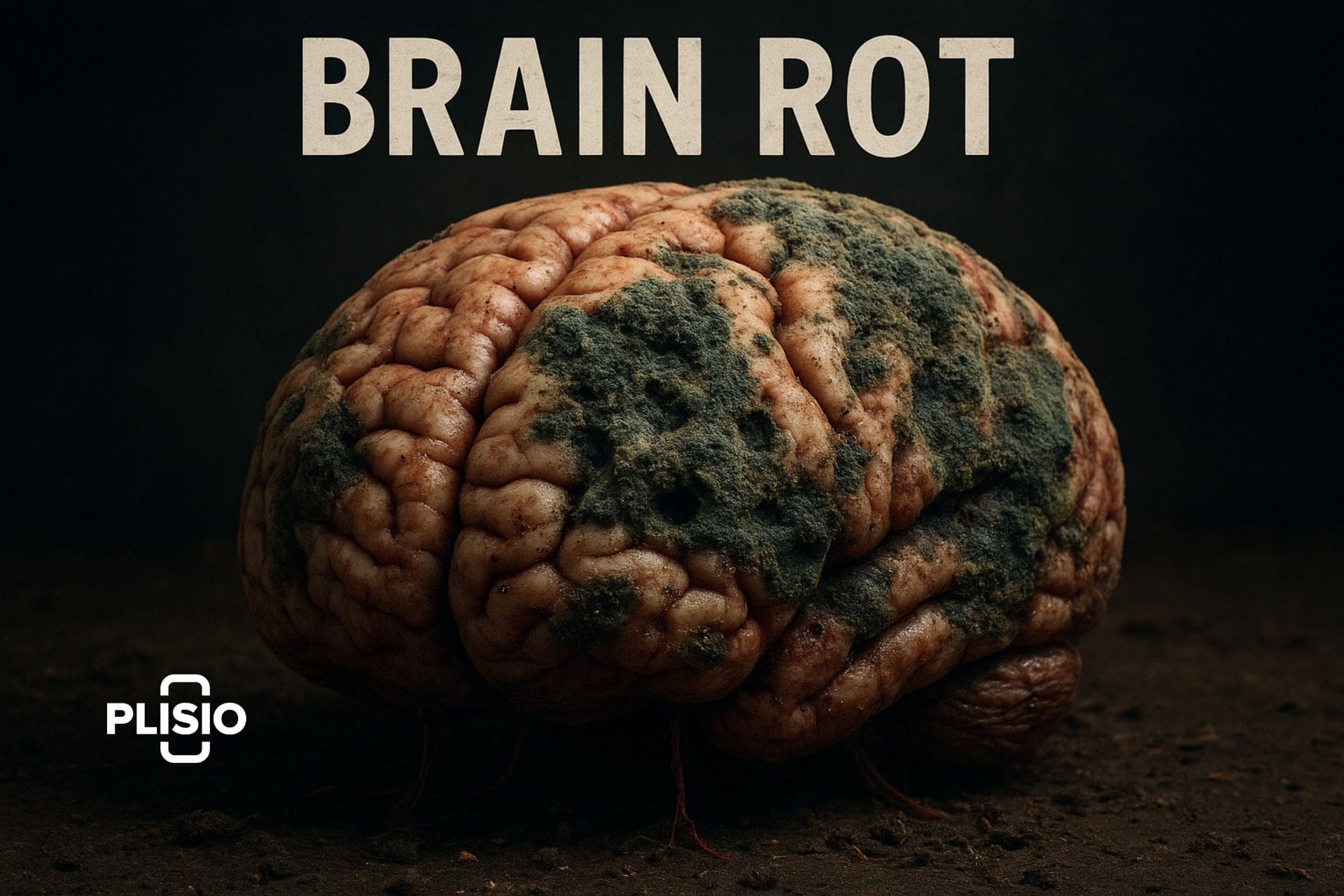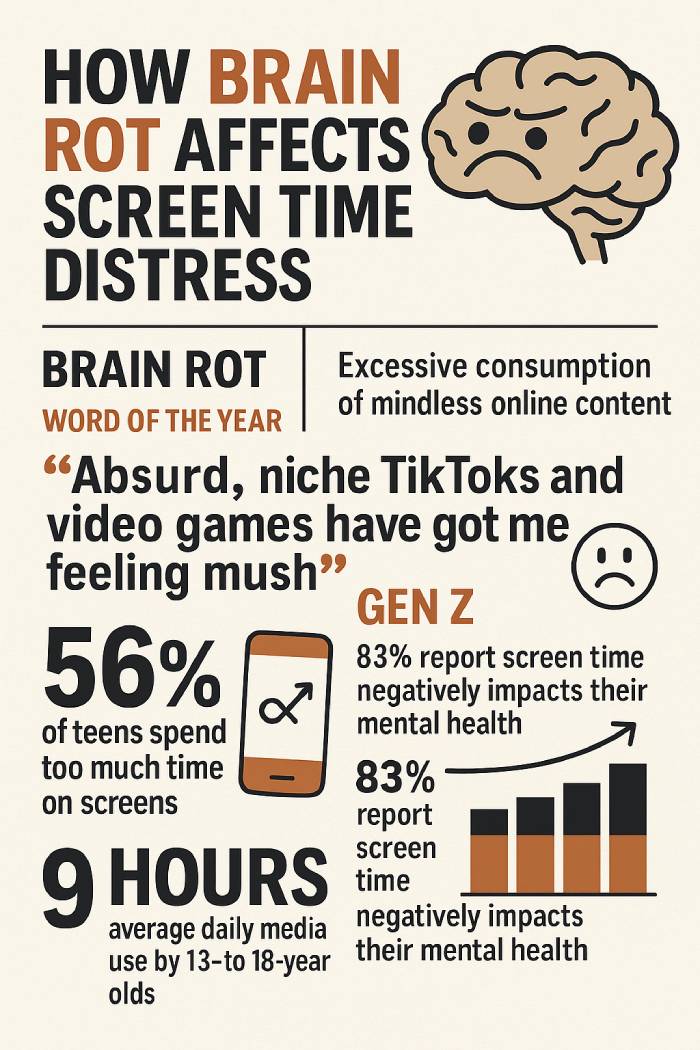What is brain rot? Parents` Guide

Have you ever heard your teen say something like this?
- "What the skibidi, yo?"
- "Give him the fanum tax"
- "I wrote the rizzdependence declaration."
- "He's a total sigma, no lie"
If any of this sounds similar, you might be seeing what is now generally known as "brain rot." Oxford University Press named "brain rot" the word of the year in 2024. It means the mental fuzziness or cognitive degeneration people feel after spending too much time watching useless online stuff. Teenagers are more likely to use slang and viral expressions they pick up on social media, TikToks, video games, and other specialty sites.
Brain Rot: Oxford's Word of the Year and What It Means for Your Brain
Brain rot is not a medical ailment or a clinical diagnostic. Instead, it's a cultural shorthand for what happens when the brain gets too much stimulation from endless scrolling, brief films, silly memes, and low-quality content. There are a lot of fun but repetitive and shallow messages on social media these days. They may appear harmless, but too much of them can make it hard to concentrate, control your emotions, and keep your mental health in good shape.
A Pew Research Center survey from 2026 says that 78% of U.S. teens feel the need to check their phones every hour. Almost half of them claim that too much screen time makes it hard for them to focus. Brain rot is both the reason for and the result of this change in behavior.
How Brain Rot Affects Your Daily Life and Free Time
For instance, I used to think my son made up the phrase "only in Ohio" because he said it every time he saw anything strange on a trip to see family. that turns out that was part of a meme that was circulating around. It made me think about how much of his vocabulary stemmed from things he read online. These phrases that are used over and over again and the terminology that makes your brain rot spread swiftly and became a part of how teens talk.
This kind of media use can influence how young people talk, think, and even how they react to the world around them, even if you don't see it right away.

How to Spot Brain Rot Symptoms and Their Effects on Mental Health
There isn't one definite sign of brain rot, yet a lot of people say it is:
* Mental fog or slow thinking * Not being able to focus * Having less cognitive ability * Always wanting to scroll or check a screen * Feeling like you have too much to do every day More anxious or irritable
A 2026 survey by Common Sense Media revealed that teens spend an average of 7.5 hours a day using screens outside of school-related activities. 62% of parents say they have seen evidence of emotional discomfort in their kids because they use media too much.
What Kind of Content Makes Your Brain Rot
Brainrot material, or low-quality information, is the kind of content that is easy to read but doesn't really do anything. It doesn't make the brain work harder or help it grow. Here are several examples:
* Clickbait articles with headlines that are too exciting * Reaction videos that don't add anything new * Viral TikToks that tell the same jokes over and again * Mindless memes and skibidi toilet clips * Influencer material that encourages unrealistic ways of living
* Content that makes you too emotional or angry * Ads that look like entertainment
Research in neuroscience from 2026 shows that youngsters who are exposed to dopamine-triggering content over and again may become desensitized, meaning their brains need more stimulation to get the same degree of reward. This makes them more likely to get addicted to media.
How Brain Rot and Too Much Screen Time Affect Teens and Gen Z
It's not unusual to see adolescents at school hooked to their phones and not paying attention to what's going on around them. What used to be boring times that made people creative or curious are now times when people swipe through silly memes and popular language. When youngsters spend all their leisure time watching TV or playing video games, they miss out on chances to interact with others on a deeper level or think quietly.
Kids who spend too much time on screens typically say:
* Having trouble accomplishing homework * Having trouble paying attention in class * Having trouble having meaningful discussions * Having a shorter attention span * Feeling bad when not connected to screens
The American Academy of Pediatrics says that kids should only spend two hours a day on screens for fun, but surveys reveal that the average teen currently spends more than three hours a day on screens for fun.
Brain Rot: How Much More Screen Time We Have Now
People from earlier generations didn't have as much access to TV or shared family computers. Teenagers and younger kids today have phones, tablets, several TVs, and gaming consoles that all want their attention. There is too much content. Every day, social media apps and sites post millions of videos, many of which are silly, repetitious, or shallow on purpose.
Even things that seem harmless, like game comments or amusing filters, might hurt your brain if you watch too much of them. And even though the vernacular may change (from "Batman smells" to "skibidi bop yes yes"), the main problem is the same: content that is meant to entertain but not feed.
How Brain Rot Spreads to Different Apps and Platforms
Brain rot spreads quickly on sites like YouTube, TikTok, Instagram, and Twitch. One meme can go across the world in a day. Teenagers say things like "low taper fade" or "sigma male" over and over again without knowing where they originated from. The lingo becomes a social code, a way for young people to talk to each other that keeps them from thinking more deeply.
Even people who don't use social media can learn these words just by being among their friends. And as people watch more media, it's tougher to escape brain rot.
How Parents Can Help Fight Brain Rot by Cutting Down on Screen Time
Don't worry at first. Brain rot doesn't mean your brain is permanently mushy. But that means you should pay attention to how much time your youngster spends on screens. If your kid is always distracted, gets angry when they're not online, or seems to be losing interest in things, it might be time to set stricter rules.
Here are some ways to do it:
* Don't let your teen have a smartphone or access to social media right away. * Set up tech-free zones or screen-free routines at home. * Talk to them about the kinds of things they're watching. * Encourage hobbies that need focus and patience, like reading, art, or sports. * Set time limits for certain apps or platforms.
Gallup's 2026 youth behavior report says that families who imposed consistent screen time limitations observed a 42% improvement in how stable their teens' moods were and a 37% increase in how many of their teens did their schoolwork.
Being Aware of Brain Rot and Its Long-Term Effects
Digital brain rot can affect anyone, not just teens. Adults also doomscroll on social media or switch between tabs without thinking. When it happens, admit it. Take a time to think with your youngster. "Have you ever had brain fog after watching too much TikTok?" or "What kind of information makes you feel better? What makes you tired?
The point isn't to make teens feel bad for liking digital stuff. It's to assist kids become more conscious and learn to tell when using media is no longer pleasurable and has become a habit.
We can help the next generation protect their mental health, attention spans, and brain strength by acknowledging the problem, learning how it works, and eating healthier.
We can outsmart brain rot by using one screen at a time.

